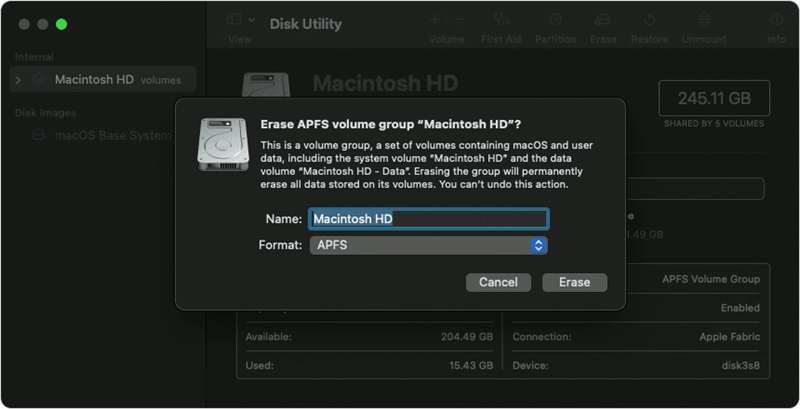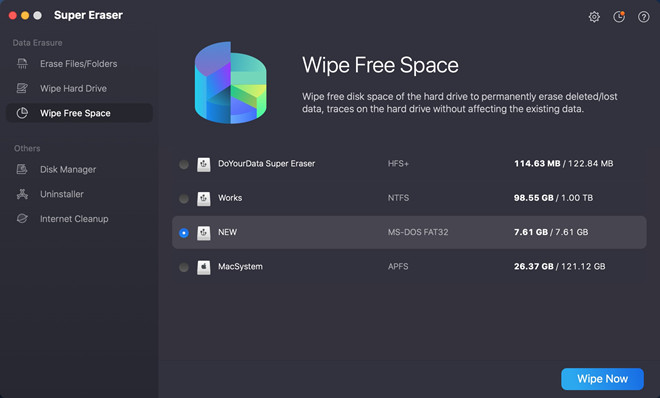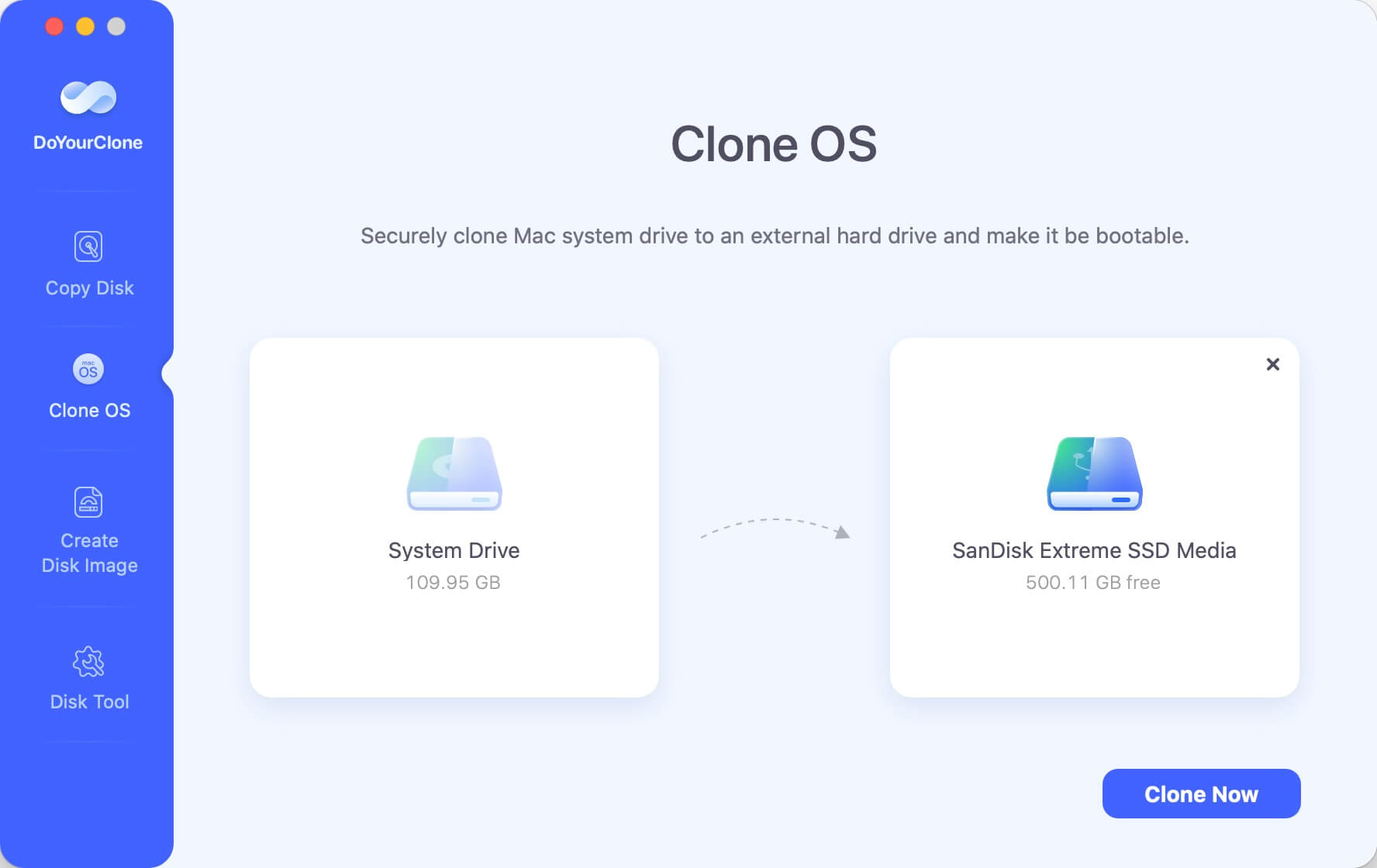Make A Full Bootable Clone Backup for Mac
Clone macOS Catalina and other data to an external hard drive and make a full bootable clone backup.
Restart your Mac, hold and press Command+R and enter into macOS Recovery mode. Then use Disk Utility to erase the startup disk and then reinstall macOS Catalina. If you will sell or donate your Mac, you should permanently erase all data stored on it. Just wipe free disk space of the Mac with DoYourData Super Eraser for Mac, all deleted/erased data will be permanently erased, leaving no trace for data recovery.
Resetting a macOS Catalina to factory settings is a drastic measure, but it's often essential before selling or trading in a Mac. This way, whoever ends up with the computer doesn't get access to your account or any of your private information.

Restoring macOS Catalina to its original settings is another option for fixing Mac crashes, software problems, viruses, and other performance issues. That will allow you to treat the macOS Catalina as fresh new.
Whether or not you plan to sell your Mac, you should always back it up regularly. Our data is extremely important to us, and its loss would have serious consequences. If you are the risk-taking type, however, we advise you to make a copy of your Mac's data before you part with it.
The ability to take a comprehensive backup of a Mac is a must for restoring any lost data. These are some of our favorites among the many options for backing up a Mac.
Make A Full Bootable Clone Backup for Mac
Clone macOS Catalina and other data to an external hard drive and make a full bootable clone backup.
If you haven't signed out of iCloud, the next person who buys your Mac could access your Find My, Notes, Contacts, and other data. Click the Apple menu and choose Sign Out from the list of options. Choose Sign Out from Apple ID > Overview.
If you don't want the app's next owner to be able to read your messages, open it up and select Messages from the main menu. Next, head to the Preferences menu and pick the iMessage option. Click Sign Out after you've chosen your account. Then, in the following window, choose Sign Out once more. Leaving FaceTime is a good analogy for this procedure.
You can't just reinstall macOS and then sell your Mac without doing more work. In most situations, this will only reinstall the System files and give you a clean copy of the operating system without affecting user data. Before selling your Mac, you should erase all your data by reformatting it in macOS Recovery Mode and installing a fresh copy. Here's a quick tutorial on how to use macOS Recovery Mode to format your Mac's hard drive.
To restart, select the Apple icon in the upper left corner of the screen.
To restart your Mac while holding down the Command and R keys, press and hold the keys simultaneously.
The Recovery Mode that comes standard on newer versions of macOS will load on your Mac.
From the pop-up window, choose Disk Utility, and then click Continue.
To reveal all connected devices, open the Disk Utility window's View menu and select Show all Devices.
Select the startup disk you wish to format and click on its name.
Select the Erase button from the menu bar.
Depending on the Mac you're using, you'll want to give your drive a name and choose either the APFS or HFS+ format.
To begin formatting the drive, select the Erase button.

Disk Utility can be closed once the task is finished. A new macOS installation can be installed after erasing and formatting the system disk.
Resetting a Mac with macOS Catalina to factory settings involves clearing out either the Parameter RAM or the Non-Volatile RAM. To perform a PRAM/NVRAM reset, power down your computer and restart it while simultaneously pressing and holding the Command, Option, Power, and Reset keys on your keyboard. After holding for around 20 seconds, let go. You can let off the keys when you hear your Mac's startup sound. When the Apple logo displays and disappears twice, you can let go of the keys on a Mac equipped with an Apple T2 security chip.
Select Continue after selecting the option to Reinstall macOS.
If you restore your Mac to its factory settings, you'll get a message on the screen saying so. Select Continue.
The terms and conditions can be accepted by clicking the Agree button.
Select storage.
Mac OS X will mechanically acquire and set up the program. It's self-restarting, too, after it's done.
Note: The erased or lost data is not lost forever after erasing Mac startup disk & reinstalling macOS. Mac data recovery software can help you recover lost files from your Mac.
Recover Lost Data on macOS Catalina
Recover deleted files or recover lost files from a hard drive which has been erased by Disk Utility with Mac data recovery software.
As said above the data is not lost forever after erasing Mac startup disk with Disk Utility or reinstalling macOS. If you will sell or donate your Mac, you should permanently wipe all sensitive data off to prevent potential data recovery.
Mac data erasure software - DoYourData Super Eraser for Mac can help you permanently erase data on Mac. It supports all macOS versions including macOS Catalina. After reinstalling macOS, you can use this software to wipe free disk space of the Mac to permanently erase all deleted/lost files on the Mac.

If you want to send away a Mac with macOS Catalina, such as a MacBook Pro or MacBook Air, some tutorials will tell you to instantly erase and reformat your Mac, which could cause problems with your data, connected devices, and Apple email.
Backing up files, logging out of all accounts, and erasing whatever information won't be restored to defaults are all important steps toward a successful factory reset on a Mac. Resetting your iMac, Mac mini, or Mac Pro to factory settings is also covered in this post..
Hot Articles

